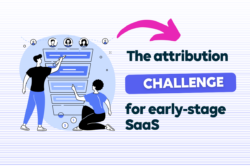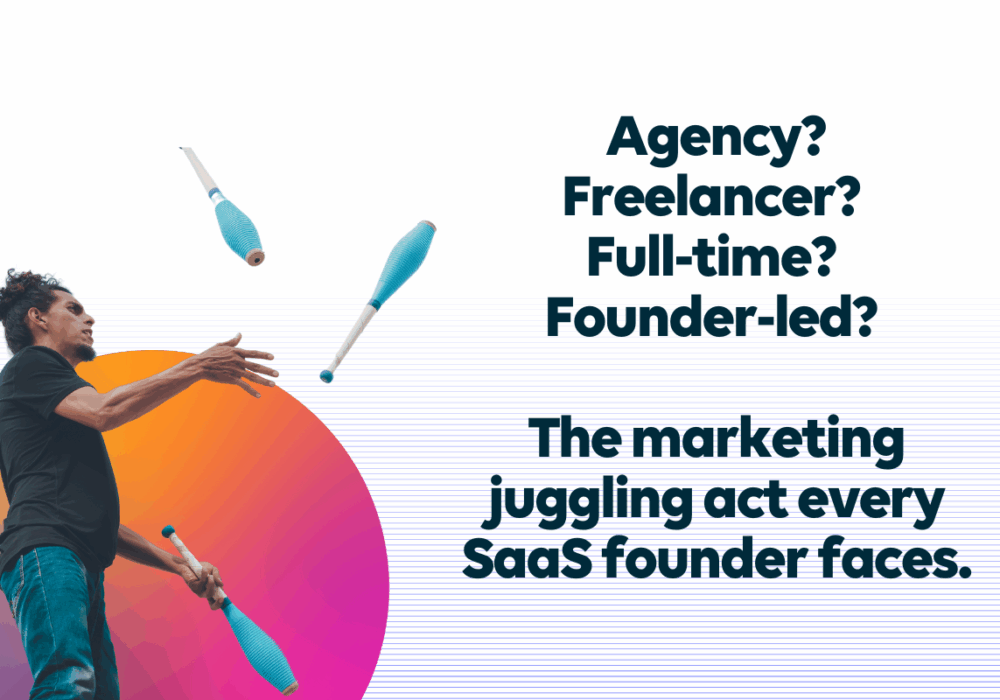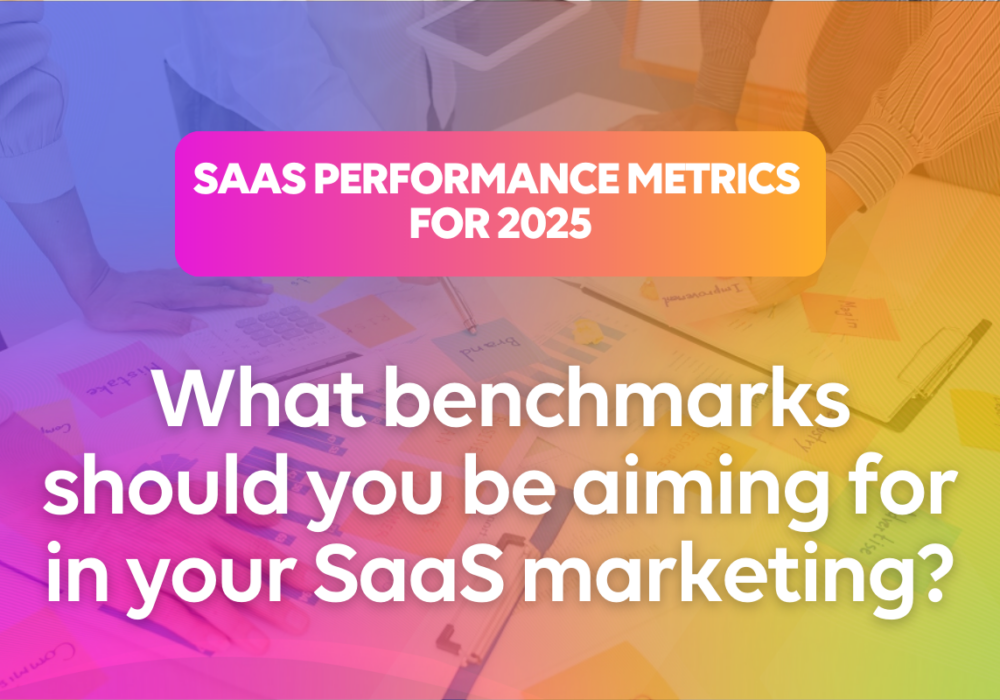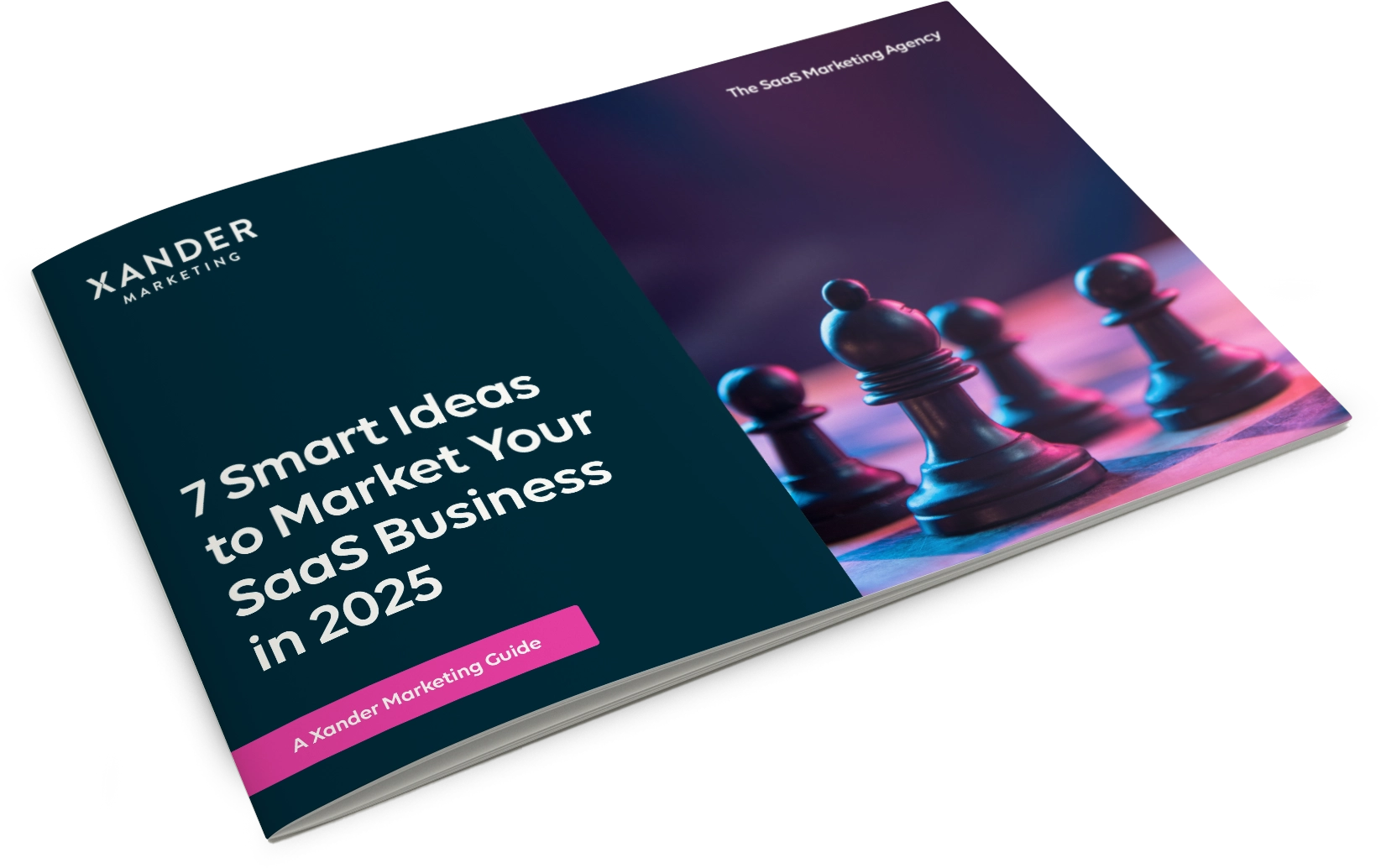From Clicks to Closed Deals: A Practical Framework for Revenue Attribution in Early-Stage SaaS
22nd May 2025
The Attribution Challenge for Early-Stage SaaS
Every SaaS founder faces that inevitable question: “Which marketing activities are actually driving revenue?” It’s a straightforward query with a frustratingly complex answer. Particularly when you’re operating with limited data, budget constraints, and a small team wearing multiple hats.
For early-stage SaaS companies, the attribution challenge is rather like trying to bake a cake while simultaneously inventing the recipe. You know revenue is coming in, you’re doing various marketing activities, but connecting those dots with precision feels nearly impossible.
The truth is, most early-stage companies fall into one of two traps: they either attempt to implement enterprise-level attribution models without the necessary infrastructure (creating a house of cards built on questionable data) or they abandon measurement altogether in favour of gut instinct (equally problematic for scaling efficiently).
Neither approach serves you well. What’s needed is a pragmatic middle path, a framework that acknowledges your limitations while still providing actionable insights to guide your marketing investments.
Building Your Attribution Foundation
Before diving into models and methodologies, let’s address the fundamentals. You need basic infrastructure in place to capture the right signals without breaking the bank or overwhelming your team.
Essential Tracking Infrastructure
For cash-conscious startups, your attribution foundation should include:
- Essential tools:
- Google Analytics 4 (free and powerful)
- UTM parameter strategy (consistent naming conventions are crucial)
- CRM integration (HubSpot, Pipedrive, or similar)
- Form tracking on key conversion points
- Critical touchpoints to monitor:
- First website visit source
- Lead magnet or content downloads
- Demo/trial requests
- Sales meeting bookings
- Closed deals
The key here isn’t implementing the perfect stack, but rather ensuring consistent data collection across these touchpoints. Better to have simple, reliable data than complex, unreliable information.
As Tom, founder of a seed-stage analytics SaaS, put it: “We spent months trying to implement complex attribution before realising we didn’t even have basic UTM tracking set up properly. We stepped back, fixed the foundations, and suddenly had actionable data within weeks.”
First Principles: Attribution Models for Resource-Constrained Teams
When resources are limited, simplicity becomes a virtue. Here are practical attribution approaches that won’t require a data science team to implement:
The Last-Click+ Model
Despite its limitations, last-click attribution works reasonably well for early-stage companies with straightforward sales processes. The key is to enhance it:
- Track the last marketing touchpoint before conversion
- Supplement with “initial source” data
- Add qualitative sales feedback (more on this later)
This “Last-Click+” approach acknowledges the conversion trigger while still capturing the broader journey.
The Critical Milestone Model
For longer sales cycles, track which channels drive specific milestones:
- Awareness: First website visit
- Consideration: Content engagement/demo request
- Decision: Sales engagement/trial
Rather than trying to attribute the entire journey, identify which channels excel at moving prospects through specific stages.
The Minimum Viable Attribution Stack
For most seed-to-Series A companies, this approach provides the right balance of insight and implementation effort:
Data Collection:
- UTM parameters on all campaigns
- Form fields capturing “how did you hear about us?”
- Website behaviour tracking via GA4
- CRM opportunity source fields
- Post-sale customer surveys
- Heat tracking and website recording software using tools like Microsoft Clarity
Analysis Approach:
- Monthly attribution review meeting
- Channel performance dashboard
- Sales team feedback loop
What makes this stack “minimum viable” is its focus on actionable insights rather than perfect attribution. You’re looking for clear signals to guide decisions, not decimal-point precision.
Beyond the Click: Mapping Middle-Funnel Activities to Revenue
The attribution challenge gets particularly thorny in the middle of the funnel, where prospects often engage with multiple content pieces, emails, and touchpoints before converting.
Practical Attribution for Content Marketing
For early-stage companies investing in content, try this approach:
- Content Influence Tracking: Create content groupings in GA4 and track which content pieces are frequently consumed before conversions
- Conversion Path Analysis: Identify common sequences (blog → whitepaper → demo request)
- Time Decay Credit: Assign weighted values to content pieces based on their position in the journey
Even with basic tools, you can identify patterns like “prospects who read our comparison guides convert at 3x the rate of other traffic sources.”
Email and Nurture Attribution
For nurture campaigns, implement these simple but effective measurements:
- Track which emails drive re-engagement with the website
- Monitor conversion rates from different nurture sequences
- Tag leads in your CRM based on engagement level with email content
This approach won’t give you perfect attribution, but it will reveal which content themes and email approaches drive pipeline momentum.
The Human Element: Blending Quantitative and Qualitative Signals
The most overlooked attribution source in early-stage companies is often the simplest: asking your customers directly. While automated tracking is valuable, human intelligence provides context that algorithms miss.
Structured Sales Intelligence Gathering
Implement these practices to enhance your attribution:
- Standardised Discovery Questions: Train sales to consistently ask “What prompted you to look for a solution now?” and “How did you first hear about us?”
- Deal Influence Documentation: Create a simple field in your CRM where sales records marketing touchpoints mentioned during calls
- Win/Loss Analysis: Conduct brief interviews focused on the decision journey
One SaaS founder shared: “We discovered our technical guides were mentioned in 40% of sales calls, despite driving only 5% of direct demo requests. This completely changed our content strategy.”
The Sales-Marketing Feedback Loop
Create a regular meeting rhythm where marketing and sales share intelligence:
- Marketing presents channel performance data
- Sales provides qualitative feedback on lead quality
- Together, identify patterns and adjust attribution weights
This collaborative approach helps refine your attribution model based on real-world sales interactions.
Channel-Specific Attribution Strategies
Different marketing channels require tailored attribution approaches. Here are pragmatic strategies for common SaaS channels:
Content Marketing
- Track assisted conversions (content viewed before conversion)
- Monitor time on page and bounce rates as quality indicators
- Implement content scoring based on conversion correlation
- Use custom campaign parameters for content promotion
Paid Media
- Implement post-click engagement tracking (not just click-through)
- Monitor CPL alongside quality indicators (call booking rates)
- Create campaign naming conventions that survive across platforms
- Consider position-based attribution for paid campaigns
Events and Webinars
- Use unique landing pages and offer codes
- Track post-event engagement (who visited, who booked meetings)
- Implement 90-day attribution windows for enterprise events
- Survey new customers about event influence
The key with channel-specific attribution is matching the method to the channel’s sales cycle position. Direct response channels (like PPC) work well with last-click, while relationship channels (like events) require longer-term influence measurement.
From MQLs to Revenue: Connecting Marketing Activities to Closed Deals
The ultimate attribution challenge is connecting early marketing touchpoints to closed revenue-particularly with B2B sales cycles stretching 3-6 months or longer.
Establishing Realistic Timeframes
Create attribution windows based on your actual sales cycle:
- Analyse your last 20 closed deals to determine the average sales cycle length
- Set primary attribution windows to match the full cycle
- Create stage-based attribution for pipeline progression
For a typical seed-stage SaaS with a 90-day sales cycle, you might use:
- 15-day window for MQL generation attribution
- 45-day window for SQL generation attribution
- 90-day window for revenue attribution
This staged approach prevents premature judgment of channels that influence earlier stages of the journey.
Correlation vs. Causation
While perfect causality is challenging to establish, look for strong correlations:
- Identify content or channels with high representation in closed deals
- Track changes in conversion rates when specific channels are paused/resumed
- Compare cohorts exposed to different marketing tactics
As one SaaS marketing director noted: “We don’t need mathematical certainty – we need confidence that Channel A is meaningfully outperforming Channel B to make decisions.”
Implementation Guide: Setting Up Your Attribution Framework
Let’s move from theory to practice with a step-by-step implementation plan:
1. UTM Strategy Development
Create a consistent UTM structure covering:
- Source (the platform: Google, LinkedIn, etc.)
- Medium (the channel type: CPC, email, social, etc.)
- Campaign (the specific initiative)
- Content (the specific asset or variation)
Document this in a shared resource and ensure all team members follow the conventions.
2. CRM Configuration
Set up your CRM to capture:
- Original lead source
- Last touch before conversion
- Key content interactions
- Sales activity milestones
For early-stage companies using HubSpot or similar tools, this often requires only 3-5 custom fields.
3. Conversion Tracking Implementation
Focus on tracking three key conversion types:
- Top-funnel conversions (newsletter signups, content downloads)
- Mid-funnel conversions (demo requests, trial signups)
- Bottom-funnel conversions (paid conversions, expansions)
4. Reporting Setup
Create a simple dashboard showing:
- Channel performance by conversion stage
- Content influence on pipeline
- Attribution by model comparison
- Cost per acquisition by channel
Even with basic tools like Looker Studio connected to GA4 and a spreadsheet, you can build this fundamental reporting.
Beyond First Purchase: Measuring Expansion and Retention Drivers
For SaaS companies, the initial sale is just the beginning. Your attribution model should extend to expansion revenue and retention.
Expansion Attribution Approaches
- Track which content/channels create customers who expand faster
- Monitor engagement with educational content and correlation with upsells
- Implement “expansion journey” tracking for key account growth
Connecting Early Touchpoints to LTV
Create cohort analyses to identify patterns:
- Do customers from certain channels expand more reliably?
- Which early engagement patterns predict higher LTV?
- What content consumption correlates with successful product adoption?
One B2B SaaS company discovered leads who engaged with their ROI calculator before becoming customers had 40% higher second-year value than average customers, a finding that dramatically changed their content promotion strategy.
Making Decisions with Imperfect Data
Perhaps the most important skill in early-stage attribution is making confident decisions despite data limitations.
The Confidence Threshold Framework
Rather than seeking perfect data, establish confidence thresholds for different decisions:
Low-stakes decisions (content topics, email subject lines):
- Require minimal attribution data
- Can proceed with 60-70% confidence
- Allow for rapid testing and iteration
Medium-stakes decisions (channel budget allocation, campaign strategy):
- Require multi-touch data points
- Should have 70-80% confidence
- Benefit from both quantitative and qualitative signals
High-stakes decisions (major channel investments, team hiring):
- Require robust attribution data
- Should have 80%+ confidence
- Need correlation from multiple models
As your attribution model matures, you can gradually increase the confidence requirements for each decision level.
Balancing Data with Judgment
Even the most sophisticated attribution models require human judgment to interpret. Create a decision-making framework that incorporates:
- Attribution data from your model
- Sales team feedback
- Customer interviews
- Competitive intelligence
- Industry benchmarks
This balanced approach prevents both data blindness (following the numbers without context) and data ignorance (dismissing metrics in favour of pure intuition).
Attribution Evolution Through the Startup Journey
Let’s examine how a B2B SaaS company could evolve their attribution approach from seed to Series A:
Phase 1: Pre-seed (£0-500K ARR)
- Manual tracking in spreadsheets
- “How did you hear about us?” as primary attribution
- Founder-led analysis of general patterns
Phase 2: Seed (£500K-1.5M ARR)
- Basic GA implementation with UTM parameters
- CRM source tracking
- Monthly review of channel performance
- Last-click attribution with sales input
Phase 3: Early Growth (£1.5M-3M ARR)
- Multi-touch attribution for key journeys
- Content influence mapping
- Channel efficiency metrics (CAC, CAC payback)
- Regular attribution model review and refinement
Principles to Scale With
- Start simple, but start now – even basic tracking beats guesswork
- Prioritise consistency over sophistication in data collection
- Build marketing-sales alignment around attribution
- Evolve your model as your company grows
- Use attribution to identify patterns, not just justify decisions
From Attribution to Optimisation
Attribution isn’t the end goal, it’s the means to optimise your marketing investments for maximum growth efficiency.
As your attribution model matures, use it to:
- Double down on high-performing channels
- Refine content strategy based on influence patterns
- Optimise the buyer journey based on conversion data
- Allocate resources more effectively across the funnel
- Build credibility for marketing investments with concrete ROI data
The most successful early-stage companies view attribution as an evolving journey rather than a destination. They start with simple models, collect consistent data, and gradually increase sophistication as they scale.
Your attribution framework doesn’t need to be perfect, it needs to be better than guesswork and capable of evolution. By focusing on the fundamentals, embracing both quantitative and qualitative signals, and making decisions with appropriate confidence thresholds, you can build a pragmatic attribution approach that grows with your business.
Need Help Optimising Your Revenue Framework?
Ready to build a revenue attribution framework that works for your stage? Xander Marketing has helped over 200 SaaS businesses implement effective marketing measurement systems that drive growth decisions. Get in touch today for a free 30-minute consultation.






